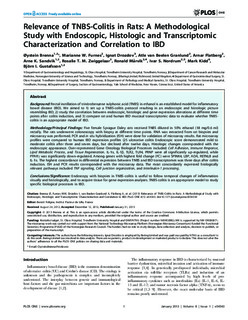| dc.contributor.author | Brenna, Øystein | |
| dc.contributor.author | Furnes, Marianne Waldum | |
| dc.contributor.author | Drozdov, Ignat | |
| dc.contributor.author | Granlund, Atle Van Beelen | |
| dc.contributor.author | Flatberg, Arnar | |
| dc.contributor.author | Sandvik, Arne Kristian | |
| dc.contributor.author | Zwiggelaar, Rosalie | |
| dc.contributor.author | Mårvik, Ronald | |
| dc.contributor.author | Nordrum, Ivar Skjåk | |
| dc.contributor.author | Kidd, Mark | |
| dc.contributor.author | Gustafsson, Björn | |
| dc.date.accessioned | 2015-11-24T08:14:13Z | |
| dc.date.accessioned | 2015-12-09T14:45:36Z | |
| dc.date.available | 2015-11-24T08:14:13Z | |
| dc.date.available | 2015-12-09T14:45:36Z | |
| dc.date.issued | 2013 | |
| dc.identifier.citation | PLoS ONE 2013, 8(1) | |
| dc.identifier.issn | 1932-6203 | |
| dc.identifier.uri | http://hdl.handle.net/11250/2367385 | |
| dc.description.abstract | Background:
Rectal instillation of trinitrobenzene sulphonic acid (TNBS) in ethanol is an established model for inflammatory bowel disease (IBD). We aimed to 1) set up a TNBS-colitis protocol resulting in an endoscopic and histologic picture resembling IBD, 2) study the correlation between endoscopic, histologic and gene expression alterations at different time points after colitis induction, and 3) compare rat and human IBD mucosal transcriptomic data to evaluate whether TNBS-colitis is an appropriate model of IBD.
Methodology/Principal Findings:
Five female Sprague Daley rats received TNBS diluted in 50% ethanol (18 mg/0.6 ml) rectally. The rats underwent colonoscopy with biopsy at different time points. RNA was extracted from rat biopsies and microarray was performed. PCR and in situ hybridization (ISH) were done for validation of microarray results. Rat microarray profiles were compared to human IBD expression profiles (25 ulcerative colitis Endoscopic score demonstrated mild to moderate colitis after three and seven days, but declined after twelve days. Histologic changes corresponded with the endoscopic appearance. Over-represented Gene Ontology Biological Processes included: Cell Adhesion, Immune Response, Lipid Metabolic Process, and Tissue Regeneration. IL-1α, IL-1β, TLR2, TLR4, PRNP were all significantly up-regulated, while PPARγ was significantly down-regulated. Among genes with highest fold change (FC) were SPINK4, LBP, ADA, RETNLB and IL-1α. The highest concordance in differential expression between TNBS and IBD transcriptomes was three days after colitis induction. ISH and PCR results corresponded with the microarray data. The most concordantly expressed biologically relevant pathways included TNF signaling, Cell junction organization, and Interleukin-1 processing.
Conclusions/Significance:
Endoscopy with biopsies in TNBS-colitis is useful to follow temporal changes of inflammation visually and histologically, and to acquire tissue for gene expression analyses. TNBS-colitis is an appropriate model to study specific biological processes in IBD. | |
| dc.language.iso | eng | |
| dc.publisher | Public Library of Science | |
| dc.title | Relevance of TNBS-Colitis in Rats: A Methodological Study with Endoscopic, Historical and Transcripttomic Characterization and Correlation to IBD | |
| dc.type | Journal article | |
| dc.type | Peer reviewed | en_GB |
| dc.date.updated | 2015-11-24T08:14:13Z | |
| dc.source.journal | PLoS ONE | |
| dc.identifier.doi | 10.1371/journal.pone.0054543 | |
| dc.identifier.cristin | 1007393 | |
| dc.relation.project | Norges forskningsråd: 223255 | |
| dc.description.localcode | © 2013 Brenna et al. This is an open-access article distributed under the terms of the Creative Commons Attribution License, which permits unrestricted use, distribution, and reproduction in any medium, provided the original author and source are credited. | |
